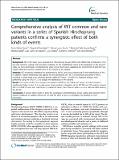Por favor, use este identificador para citar o enlazar a este item:
http://hdl.handle.net/10261/42225COMPARTIR / EXPORTAR:
 SHARE SHARE
 CORE
BASE CORE
BASE
|
|
| Visualizar otros formatos: MARC | Dublin Core | RDF | ORE | MODS | METS | DIDL | DATACITE | |

| Título: | Comprehensive analysis of RET common and rare variants in a series of Spanish Hirschsprung patients confirms a synergistic effect of both kinds of events |
Autor: | Núñez-Torres, Rocío; Fernández, Raquel M. CSIC ORCID; Acosta, Manuel Jesús; Enguix-Riego, María del Valle; Marbá, Martina; Agustín, Juan Carlos de; Castaño, Luis; Antiñolo, Guillermo CSIC ORCID; Borrego, Salud CSIC ORCID | Fecha de publicación: | 13-oct-2011 | Editor: | BioMed Central | Citación: | BMC Medical Genetics 12(1): (2011) | Resumen: | [Background] RET is the major gene associated to Hirschsprung disease (HSCR) with differential contributions of its rare and common, coding and noncoding mutations to the multifactorial nature of this pathology. In the present study, we have performed a comprehensive study of our HSCR series evaluating the involvement of both RET rare variants (RVs) and common variants (CVs) in the context of the disease. [Methods] RET mutational screening was performed by dHPLC and direct sequencing for the identification of RVs. In addition Taqman technology was applied for the genotyping of 3 RET CVs previously associated to HSCR, including a variant lying in an enhancer domain within RET intron 1 (rs2435357). Statistical analyses were performed using the SPSS v.17.0 to analyze the distribution of the variants. [Results] Our results confirm the strongest association to HSCR for the "enhancer" variant, and demonstrate a significantly higher impact of it in male versus female patients. Integration of the RET RVs and CVs analysis showed that in 91.66% of cases with both kinds of mutational events, the enhancer allele is in trans with the allele bearing the RET RV. [Conclusions] A gender effect exists on both the transmission and distribution of rare coding and common HSCR causing mutations. In addition, these RET CVs and RVs seem to act in a synergistic way leading to HSCR phenotype. |
Versión del editor: | http://dx.doi.org/10.1186/1471-2350-12-138 | URI: | http://hdl.handle.net/10261/42225 | DOI: | 10.1186/1471-2350-12-138 | ISSN: | 1471-2350 |
| Aparece en las colecciones: | (IBIS) Artículos |
Ficheros en este ítem:
| Fichero | Descripción | Tamaño | Formato | |
|---|---|---|---|---|
| 1471-2350-12-138.xml | 62,22 kB | XML | Visualizar/Abrir | |
| 1471-2350-12-138.pdf | 450,14 kB | Adobe PDF |  Visualizar/Abrir | |
| 1471-2350-12-138-S1.DOC | 43,5 kB | Microsoft Word | Visualizar/Abrir |
CORE Recommender
PubMed Central
Citations
10
checked on 08-abr-2024
SCOPUSTM
Citations
16
checked on 16-abr-2024
WEB OF SCIENCETM
Citations
15
checked on 22-feb-2024
Page view(s)
329
checked on 18-abr-2024
Download(s)
453
checked on 18-abr-2024
Google ScholarTM
Check
Altmetric
Altmetric
Artículos relacionados:
NOTA: Los ítems de Digital.CSIC están protegidos por copyright, con todos los derechos reservados, a menos que se indique lo contrario.
